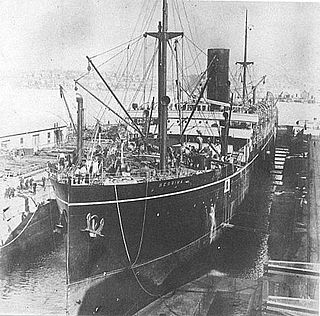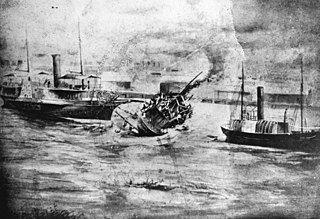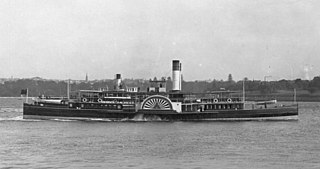
A paddle steamer is a steamship or steamboat powered by a steam engine that drives paddle wheels to propel the craft through the water. In antiquity, paddle wheelers followed the development of poles, oars and sails, where the first uses were wheelers driven by animals or humans.

MV The Second Snark is a small passenger ferry, built in 1938 by William Denny of Dumbarton, later operated by Clyde Marine Services on the Firth of Clyde, Scotland.

William Denny and Brothers Limited, often referred to simply as Denny, was a Scottish shipbuilding company.

A & J Inglis, Ltd, was a shipbuilding firm founded by Anthony Inglis and his brother John, engineers and shipbuilders in Glasgow, Scotland in 1862. The firm built over 500 ships in a period of just over 100 years. Their Pointhouse Shipyard was at the confluence of the rivers Clyde and Kelvin. They constructed a wide range of ships, including Clyde steamers, paddle steamers and small ocean liners. In wartime, they built small warships, and in the period after World War II, they built a number of whalers.

Robert Napier was a Scottish marine engineer known for his contributions to Clyde shipbuilding.

PS Ryde is a paddle steamer that was commissioned and run by Southern Railway as a passenger ferry between mainland England and the Isle of Wight from 1937 to 1969, with an interlude during the Second World War where she served as a minesweeper and then an anti-aircraft ship, seeing action at D-Day. After many years abandoned on moorings at Island Harbour Marina on the River Medina, she was purchased by the PS Ryde Trust in late 2018, with the intention of raising money for her restoration. That project was abandoned in January 2019.

South Passage is channel between the South Pacific Ocean and Moreton Bay. The other entrances to the bay are the North Passage or North Entrance and Jumpinpin Channel in the south.

HMS Hecate was a 4-gun Hydra-class paddle sloop launched on 30 March 1839 from the Chatham Dockyard.

Caird & Company was a Scottish shipbuilding and engineering firm based in Greenock. The company was established in 1828 by John Caird when he received an order to re-engine Clyde paddle-tugs.

PS Caledonia was a paddle steamer built in 1934. She principally provided an Upper Clyde ferry service, later moving to Ayr and then Craigendoran.

The Australasian United Steam Navigation Company (AUSNC) was an Australian shipping company formed in 1887 by the merger of the Australasian Steam Navigation Company and the Queensland Steam Shipping Company and their fleets. It existed from 1887 to 1961.

SS (RMS) King Orry (II) No. 45479 – the second vessel in the company's history to bear the name – was an iron paddle-steamer operated by the Isle of Man Steam Packet Company.
The Queensland Steam Shipping Company was a shipping company of Australia from 1881 to 1887.

The capsize of the ferry Pearl occurred on Thursday 13 February 1896 in the Brisbane River, Queensland, Australia. Many people died.
Bishop Island was an island near the mouth of the Brisbane River in Moreton Bay, Queensland, Australia.

SS Bingera was a steamship that provided the mail service between Brisbane, Gladstone and Townsville in Queensland, Australia.

Joseph William Sutton, identified in the print media as J. W. Sutton, was an Australian engineer, shipbuilder, inventor, pioneer in electric lighting and x-ray pioneer in Queensland.
The Kalara was an iron paddle steamer built in 1881 by Smith, Forrester, and Co., and launched at Kangaroo Point for Messrs. D. L. Brown and Co. It ran regular trips between Brisbane and the Tweed River. On Saturday 6 November 1886 the Kalara whist exiting the tweed river ran over its own anchor and pierced its hull causing it to sink approximately 30 minutes later approximately one mile north-east of Point Danger and from the Tweed River bar in 15 fathoms.

Emu, later Brightside, was an iron-hulled paddle steamer that was built in Scotland in 1864 for use in Australia. For her first few years she worked on the Brisbane River and Moreton Bay. From 1868 she was a local ferry in Sydney Harbour. From 1902 she was a cargo ship. She was scrapped in Sydney in 1909.

SS Canonbar was a steam cargo ship built in Ardrossan, Scotland in 1910 for the North Coast Steam Navigation Company, and used in the Australian coastal trade. During World War II, she was part of the US supply fleet in the Pacific Ocean. From 1949, she was Rosita, until 1960, when she was renamed Valiente. Under the name Kettara IV, she was sunk by shell fire off the Vietnamese coast in 1966, with the loss of her entire crew.



















